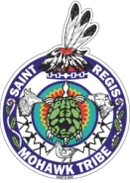Culture and History
The Mohawk are traditionally the keepers of the Eastern Door of the Iroquois Confederacy, also known as the Six Nations Confederacy or the Haudenosaunee Confederacy. Our original homeland is the north eastern region of New York State extending into southern Canada and Vermont. Prior to contact with Europeans the Mohawk settlements populated the Mohawk Valley of New York State. Through the centuries Mohawk influence extended far beyond their territory and was felt by the Dutch who settled on the Hudson River and in Manhattan. The Mohawks’ location as the Iroquois nation closest to Albany and Montreal, and the fur traders there, gave them considerable influence among the other Tribes. This location has also contributed directly to a long and beautifully complicated history.
In the 1750s, to relieve crowding at Kahnawake and to move closer to the Iroquois homeland, the French Jesuits established a mission at the present site on the St. Regis River. The Mohawk people had continually used this site at the confluence of the St. Lawrence River Valley as part of our fishing and hunting grounds prior to the building of the first church. “Akwesasne” as it is known today, translates roughly to “Land where the partridge drums” has always been a prime location due to the confluence of several small rivers and the St. Lawrence River. The Catholic Church records date back to the late 1600’s. Oral history states the church was built on traditional ceremonial grounds.
The community became more populated as Mohawks left the Mohawk Valley under distressed conditions in the mid 1700’s. In 1759 a band of Abenakis sought refuge with the Mohawk people during the French and Indian War, with some remaining behind after their party returned to their own village. In addition, also as a result of the dislocation caused by the war, a number of refugees from the Oswegatchie Mission (near present day Ogdensburg, NY) settled at Saint Regis. After this immigration, the culture at Saint Regis stayed predominately Mohawk. In 1796 the Seven Nations of Canada, which included Christian Mohawks living in St. Regis asserted rights to their lands and were eventually confined to a small parcel of land through a treaty signed by representatives of the Seven Nations of Canada and the State of New York. Today the Mohawk people of Akwesasne still rightfully claim territory outside the confines of the current boundaries of the reservation and exercise guardianship over these lands through National Historic Preservation Act, Section 106 and Environmental Protection Act processes.
In 1888, at a Grand Council of the Six Nations Iroquois Confederacy (Haudenosaunee Confederacy), the Mohawk Nation formally rekindled their fire and responsibilities to the Confederacy as the successor of the descendents of Mohawks who had left the Mohawk Valley a hundred years earlier. The Mohawk people who had maintained their traditional customs and ceremonies restored their place as an “Elder Brother” of the Haudenosaunee. The Confederacy felt it was beneficial to all to remain united, therefore strengthening its position when fighting for Indian rights under treaties previously negotiated with the United States.
After the American War of Independence, the Mohawk people found it necessary to deal with the government of the State of New York. In order to protect themselves and their best interests, the Mohawks decided to select representatives to interact with New York. In the 1930s the Federal Government proposed the Indian Reorganization Act (IRA). Each Tribe was given the opportunity to reject the IRA and the Saint Regis Mohawks did reject the Act of 1935. In 1953, a Federal task force arrived at Saint Regis to prepare termination legislation but the chiefs and Saint Regis people rejected the termination. Despite this, the Bureau of Indian Affairs proposed bill was presented to Congress where it died in committee without serious consideration.
Administrative termination of Tribes continued throughout the 1950s. In the mid-1960s, however, the Federal Government was reminded that there had been no official termination of the Federal relationship with the New York State Iroquois. The acknowledgment of the Federal relationship was slow to manifest itself. Following preliminary findings, the leaders of the Iroquois Tribes, including those of the Saint Regis, were invited to Washington to explore the establishment of a viable relationship.
